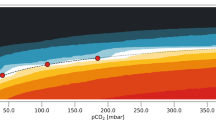Abstract
Monthly averages of the surface energy balance are parameterized, resulting in a reduced solar forcing function and a non-dimensional time scale for computing the thermal response at the air/snow interface by numerical forward integration. The climatonomic transform of the balance equation serves to assess surface-temperature perturbations resulting from parameter modifications which simulate effects of dust contamination of a snow surface. Three climatonomical model experiments permit the following conclusions: (1) an albedo reduction increases primarily the summer temperatures; (2) an emissivity decrease raises the temperature of all months nearly uniformly; (3) the thermally induced feedback on submedium structure (if summer melting is instigated) increases the storage capacity and reduces spring and summer temperatures with compensating rise in autumn and winter temperature. Quantitative results are exemplified by assumed modification of conditions known to exist at the South Polar Plateau.
Similar content being viewed by others
References
Dalrymple, P.: 1966, ‘A Physical Climatography of the Antarctic Plateau’, in Studies in Antarctic Meteorology (M. J. Rubin, ed.), pp. 195 to 231, Am. Geophys. Union Antarctic Res. Series, 9.
Dalrymple, P., Lettau, H., and Wollaston, S.: 1966, ‘South Pole Micrometeorology Program; Data Analysis’, in Studies in Antarctic Meteorology (M. J. Rubin, ed.), pp. 13 to 58, Am. Geophys. Union Antarctic Res. Series 9.
Geiger, R.: 1966, The Climate near the Ground, Harvard Univ. Press, Cambridge, Mass.
Lettau, H. and Lettau, K.: 1975, ‘Regional Climatonomy of Tundra and Boreal Forests in Canada’, in Climate of the Arctic (G. Weller and S. Bowling, eds.), pp. 209 to 221. Fairbanks, Alaska.
Lettau, H.: 1971, ‘Antarctic Atmosphere as a Test Tube for Meteorological Theories’, pp. 443–475 in Research in the Antarctic (L. Quam, ed.), Am. Assoc. Adv. Sci., Washington, D. C.
Loewe, F.: 1962, ‘On the Mass Economy of the Interior of the Antartic Ice Cap’, J. Geophys. Res. 67, 5171–5177.
Möller, F.: 1965, ‘On the Backscattering of Global Radiation by the Sky’, Tellus 17, 350–355.
Riordan, A. J.: 1976, ‘Climatonomy Model for the Dry Valleys with and without Snowcover’, Antarctic J. 11, 149–151.
Schwerdtfeger, W.: 1970, ‘The Climate of the Antarctic’, in World Survey of Climatology (H. Landsberg, ed. in chief), Vol. 14, Chapter 4, pp. 253 to 355, Elsevier Publ. Comp., Amsterdam.
Sellers, W.: 1965, Physical Climatology, University of Chicago Press, Chicago.
Author information
Authors and Affiliations
Rights and permissions
About this article
Cite this article
Lettau, H. Climatonomical modeling of temperature response to dust contamination of Antarctic snow surfaces. Boundary-Layer Meteorol 12, 213–229 (1977). https://doi.org/10.1007/BF00121974
Revised:
Issue Date:
DOI: https://doi.org/10.1007/BF00121974




